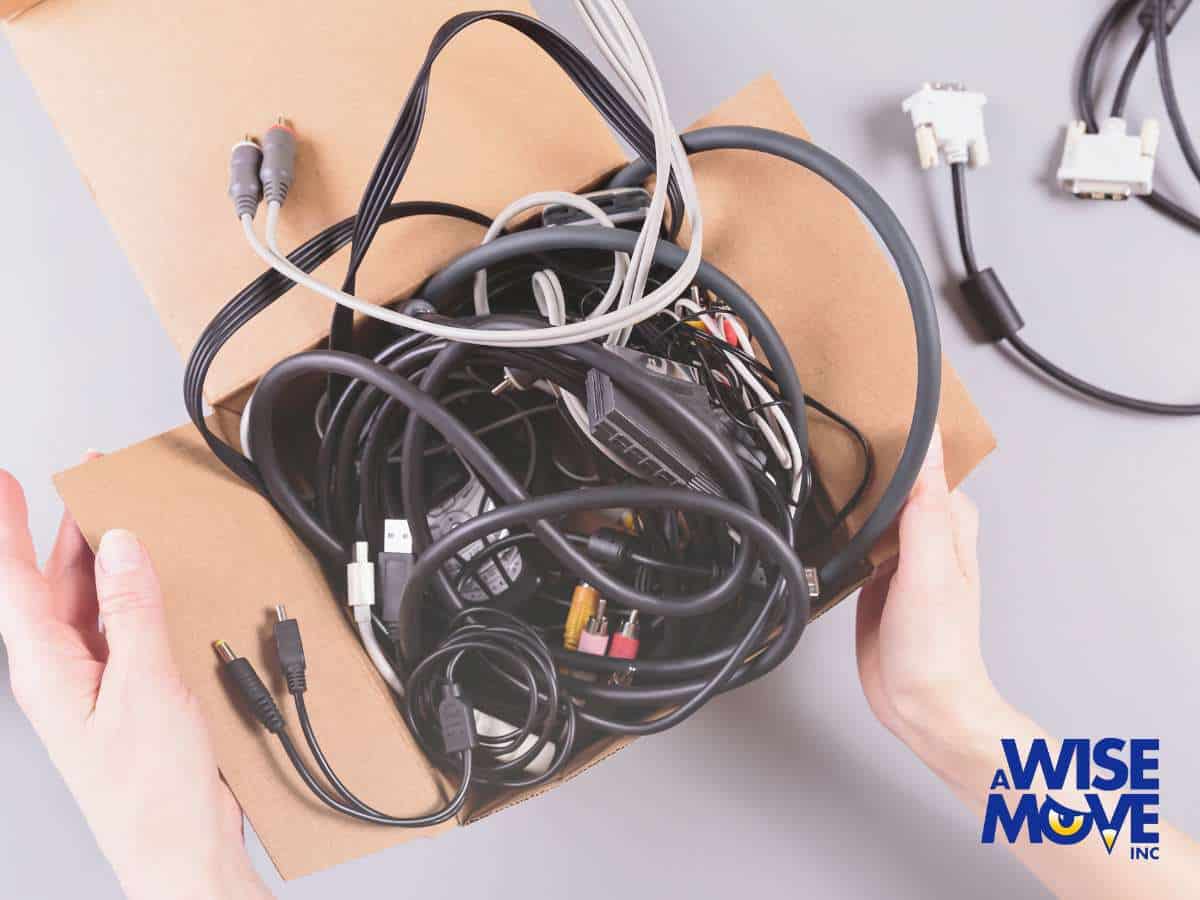How To Transport Electronics Safely During a Move
Pro Tips To Protect Your Devices
Moving electronics is nothing like moving a couch. One bump, one drop, or the wrong packing material can end up costing you a lot in repairs. At A Wise Move, your trusted movers in Phoenix, we’ve moved everything from delicate gaming PCs to massive 85-inch TVs, and over the years we’ve learned exactly how to keep them safe. In this guide, we’ll walk you through the same steps we use on the job so your electronics arrive in one piece and work just as well in your new place as they did before the move

Safe Electronics Packing & Transport
Before wrapping a single cord or unplugging a device, take time to plan how you’ll pack and transport your electronics. This step is often ignored but can make a huge difference in preventing damage and reducing post-move stress.
Start by creating a list of all the electronic items you’ll be transporting—TVs, computers, printers, sound systems, gaming consoles, kitchen appliances, and any accessories. By creating this checklist, you’ll be able to track what needs to be packed and ensure nothing gets left behind.
Next, take inventory of your packing supplies. You’ll need sturdy boxes (preferably original packaging if available), bubble wrap, packing paper, anti-static bags, among others (we’ll talk about that later). Planning early gives you time to gather these materials or purchase specialty supplies for delicate items.
It’s also smart to back up important files and photos on external drives or cloud storage, just in case something gets lost or damaged. For added protection, take photographs of how cords and components are connected, which will make reassembly much easier later.
You can easily schedule your days for planning so that you have enough time to get your items and supplies ready. Plus, you can hire a professional moving company to get help with the moving supplies.
What Packing Supplies Are Really Essential For Electronics?
You already know that planning ahead is crucial, but if you’re still unsure about what packing supplies you really need to relocate your electronics, don’t worry! Here’s a full list of the necessary items to wrap and protect your electronics for moving:
Must-haves
- Sturdy cardboard boxes: Use heavy-duty boxes or, ideally, the original packaging if available. Choose snug-fitting sizes to avoid shifting during transit.
- Anti-static bubble wrap: Protects devices from both impact and static electricity, which can damage internal components.
- Packing paper or foam sheets: Used to cushion items and fill empty spaces inside boxes to prevent movement.
- Anti-static bags: Ideal for smaller electronics, hard drives, memory cards, and circuit boards.
- Zip ties or Velcro straps: Help organize and bundle cables neatly to prevent tangling and damage.
- Cable labels or masking tape and a marker: For labeling cords and components, making reassembly quick and easy.
- Packing tape: Use strong, wide tape to seal boxes securely.
- Silica gel packets for moisture protection: Essential to absorb moisture and protect against humidity-related damage.
- Fragile stickers or labels: Mark boxes with sensitive electronics to ensure careful handling.
- Permanent marker: For labeling boxes with contents, room destination, and handling instructions.
Optionals
- Electronics cleaning supplies: Remove dust and debris before packing to prevent buildup that could cause overheating or performance issues post-move.
- Storage containers for small parts: Keep screws, adapters, and accessories organized.
- Custom crating materials for large screens: Provide reinforced protection to prevent cracks, scratches, and impact damage.
- Moisture barriers: Protect electronics from humidity and condensation, reducing the risk of water damage, corrosion, or short-circuiting.
- Corner protectors: Add cushioning to device edges to prevent chips, dents, and structural damage from accidental drops or pressure.
- Temperature monitoring devices for valuable equipment: Track environmental conditions during transit to ensure sensitive electronics are not exposed to extreme heat or cold.
Step Guide To Packing Your Electronics Safely
Packing electronics correctly is crucial to keep them safe from bumps, dust, and static damage during a move. Here’s a step-by-step guide to do it right:
Step 1: Back Up Important Data
Before packing any devices, backup files, photos, and important documents onto an external hard drive or cloud storage. This protects your data in case of damage or loss.
Step 2: Unplug & Power Down
Shut down all electronics completely and unplug them at least 24 hours before packing. This allows them to cool down and prevents internal heat damage during transport.
Step 3: Take Photos Of Cable Setups
Before disconnecting cords, take clear photos of how everything is connected. These images will help you reassemble your setup quickly and correctly later.
Step 4: Remove Batteries, Discs & Ink Cartridges
Take out batteries to prevent leaks. Remove any discs from game consoles or DVD players, and take out ink cartridges from printers to avoid spills.
Step 5: Wrap Each Item Carefully
Wrap devices in anti-static bubble wrap or foam sheets. Avoid materials that generate static electricity, like towels or regular plastic wrap.
Step 6: Use Original Boxes If Possible
If you kept the original packaging, use it—it’s designed to protect your device. Otherwise, use a box slightly larger than the item, and fill gaps with packing paper or foam.
Step 7: Bundle & Label Cord
Use zip ties or Velcro straps to bundle cords. Place them in labeled zip-top bags and tape them to the corresponding device or pack them in a separate “cables only” box.
Step 8: Seal & Label Boxes Clearly
Close boxes securely with packing tape and label them with “Fragile,” “This Side Up,” and the name of the device. Include a note about the room where it belongs for easier unpacking.
Special Considerations For High-Value Electronics
When transporting high-end electronics like home theater systems, gaming PCs, or professional audio equipment, taking extra precautions is essential. These devices are not only expensive but often include sensitive components that can be easily damaged by heat, shock, or static electricity.
We recommend using the original boxes whenever possible, but if these are no longer available, invest in double-walled or foam-padded boxes. For items like projectors, amplifiers, or custom PCs, consider using custom-cut foam inserts to provide maximum protection and reduce movement inside the box.
We also recommend using anti-static bubble wrap and anti-static bags for internal components like graphics cards or hard drives. For added protection, include silica gel packets inside the box to absorb moisture that could cause condensation damage during transit.
If possible, detach removable parts like speakers, monitor stands, or PC components such as graphics cards and RAM. Pack them separately in labeled, cushioned bags. This reduces strain on internal connectors and prevents parts from shifting during transport.
For particularly valuable or custom equipment, check if your moving company offers insurance or consider purchasing additional coverage. Having peace of mind that your investment is protected is worth the small added cost.
Unpacking & Reinstalling Electronics After a Move
Once you’ve arrived at your new home, resist the urge to rush through unpacking your electronics right away. The best you can do is to take a careful, organized approach to prevent damage and make reinstallation much smoother.
Start With Clean, Dry Surfaces
Before unpacking, make sure the area where you’ll be setting up your devices is clean, dry, and free of dust. This helps protect vents, fans, and internal components from clogging or overheating.
Unpack One Device At a Time
To stay organized, unpack and set up each electronic item individually. Refer to the photos you took before the move to reconnect cables and accessories correctly.
Check For Visible Damage
Inspect each device for signs of impact, cracks, or water damage before plugging anything in. If something looks off, hold off on powering it up and test it with a professional if needed.
Let Devices Adjust To Room Temperature
If the electronics were exposed to cold or hot temperatures during the move, allow them to reach room temperature before turning them on. This prevents condensation-related issues.
Reinstall Cables & Components
Use your labeled cords and reference photos to reconnect everything as it was. If you removed any parts (like batteries or PC components), reinstall them carefully and ensure they’re securely in place.
Test Devices Before Final Placement
Plug in and test each item before tucking cords away or mounting devices. This saves time in case adjustments or repairs are needed.
Hire A Professional Moving Company To Ensure Safety
While packing electronics carefully is important, sometimes the safest option is to leave it to the experts. Professional movers have the experience, equipment, and materials needed to handle delicate and high-value electronics with precision.
If you’re moving multiple electronic devices or high-end equipment, hiring a reputable moving company can give you peace of mind and save time during the most stressful part of your move.
At A Wise Move, we treat your electronics like our own. Our trained team uses professional-grade packing techniques to ensure your devices arrive safe, sound, and ready to use. Contact us now for a free quote and let us help you move your electronics safely!
FAQs
Can you transport electronics in a moving truck?
Yes, but they need to be packed properly to avoid damage from bumps, temperature changes, and shifting during transit. Use sturdy boxes, plenty of cushioning, and label the boxes as “Fragile” so movers handle them with care. If we’re handling your move, our crew will pack your electronics with the right materials and techniques so they travel safely in the truck and arrive in perfect condition.
How to transport electronics without the original packaging?
Wrap each item individually in anti-static materials and use cardboard dividers or foam inserts to separate them. Fill any gaps with packing paper or foam to prevent movement during transit. Our team can custom-pack multi-device boxes so everything arrives in perfect condition.
How to move electronics across the country
Pack devices in sturdy boxes with anti-static wrap, fill gaps to prevent shifting, and label as Fragile. For high-value items, consider climate-controlled transport. Our crew can pack and secure your electronics so they arrive safe, no matter the distance.
How do you protect electronics from static electricity when moving?
Use anti-static bubble wrap or anti-static bags instead of regular plastic. Static can damage internal components, especially in computers, consoles, and audio equipment. We use these materials on every move to protect sensitive devices.
Should I remove batteries before transporting electronics?
Yes. Removing batteries prevents leaks and corrosion that could damage your devices during the move. The same goes for ink cartridges in printers and discs in players or consoles.

A WISE MOVE, INC.
4150 West Northern Ave. Suite 100
Phoenix AZ 85051
Office: 623-939-9473
Email: [email protected]
Website: www.awisemoveaz.com






